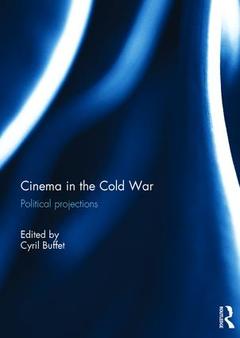Description
Cinema in the Cold War
Political Projections
Coordinator: Buffet Cyril
Language: English
Subjects for Cinema in the Cold War:
Keywords
Sovetskii Ekran; 20th Century history; West Germany; American cinema; SED; Cold War; Young Man; Cold War History; Bernauer Strasse; Communism; Trybuna Ludu; Hollywood; Polish Jewish Past; Soviet Union; Soviet Television; cinema; Angry Young Men; cultural transfers; Konrad Wolf; film industry; Polish Tv; political conflict; Kurt Maetzig; political ideology; Grigorii Aleksandrov; popular culture; Aleksandr Fursenko; propaganda; White Sun; Polish Jewish Relations; Respective Occupation Zones; CPUSA; Motion Picture Alliance; HUAC; Colin’s Mother; Soviet Movie; Hollywood Ten; Gerd Rainer Horn; American Communist Party
Publication date: 11-2015
· 17.4x24.6 cm · Hardback
Publication date: 01-2018
· 17.4x24.6 cm · Paperback
Description
/li>Contents
/li>Readership
/li>Biography
/li>
The film industry was an important propaganda element during the Cold War. As with other conflicts, the Cold War was fought not just with weapons, but with words and images. Throughout the conflict, cinema was a reflection of the societies, the ideologies, and the political climates in which the films were produced. On both sides, great stars, major companies, famous scriptwriters, and filmmakers were enlisted to help the propaganda effort.
It was not only propaganda that was created by the cinema of the Cold War ? it also articulated criticism, and the movie industries were centres of the fabrication of modern myths. The cinema was undoubtedly a place of Cold War confrontation and rivalry, and yet there were aesthetic, technical, narrative exchanges between West and East. All genres of film contributed to the Cold War: thrillers, westerns, comedies, musicals, espionage films, documentaries, cartoons, science fiction, historical dramas, war films, and many more. These films shaped popular culture and national identities, creating vivid characters like James Bond, Alec Leamas, Harry Palmer, and Rambo. While the United States and the Soviet Union were the two main protagonists in this on-screen duel, other countries, such as Britain, Germany, Poland, Italy, and Czechoslovakia, also played crucially important parts, and their prominent cinematographic contributions to the Cold War are all covered in this volume. This book was originally published as a special issue of Cold War History.
Preface1. Meeting on the Elbe (Vstrecha na El’be): A visual representation of the incipient Cold War from a Soviet perspective2. ‘Declaration of Love on Celluloid’: The depiction of the Berlin Wall in a GDR film, 1961-623. ‘The Maltz Affair’ revisited: How the American Communist Party relinquished its cultural influence at the dawn of the Cold War4. ‘Don’t Mention the Soviets!’ An overview of the short films produced by the NATO Information Service between 1949 and 19695. The destruction of New York City: A recurrent nightmare of American Cold War cinema6. Hollywood’s insidious charms: the impact of American cinema and television on the Soviet Union during the Cold War7. The Cold War’s cultural ecosystem: angry young men in British and Soviet cinema, 1953-19688. The Search for Legitimacy in Post-Martial Law Poland: The Case of Claude Lanzmann’s
Cyril Buffet is a historian specialising in international relations and German history. He is director of studies at SFiB (Berlin), Germany. He has taught at universities in France, Germany, and the UK, and has curated historical exhibitions and authored TV documentaries on a variety of cultural topics.
These books may interest you

The Cold War and Asian Cinemas 209.69 €

The Cold War and Asian Cinemas 48.88 €

